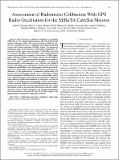| dc.contributor.author | Marinan, A. D. | |
| dc.contributor.author | Cahoy, K. L. | |
| dc.contributor.author | Bishop, R. L. | |
| dc.contributor.author | Lui, S. S. | |
| dc.contributor.author | Bardeen, J. R. | |
| dc.contributor.author | Mulligan, T. | |
| dc.contributor.author | Blackwell, W. J. | |
| dc.contributor.author | Leslie, R. V. | |
| dc.contributor.author | Osaretin, I. A. | |
| dc.contributor.author | Shields, M. | |
| dc.date.accessioned | 2017-08-15T18:37:46Z | |
| dc.date.available | 2017-08-15T18:37:46Z | |
| dc.date.issued | 2016-12 | |
| dc.identifier.issn | 1939-1404 | |
| dc.identifier.uri | http://hdl.handle.net/1721.1/110956 | |
| dc.description.abstract | The microwave radiometer technology acceleration (MiRaTA) is a 3U CubeSat mission sponsored by the NASA Earth Science Technology Office. The science payload on MiRaTA consists of a triband microwave radiometer and global positioning system (GPS) radio occultation (GPSRO) sensor. The microwave radiometer takes measurements of all-weather temperature (V-band, 50-57 GHz), water vapor (G-band, 175-191 GHz), and cloud ice (G-band, 205 GHz) to provide observations used to improve weather forecasting. The Aerospace Corporation's GPSRO experiment, called the compact total electron content and atmospheric GPS sensor (CTAGS), measures profiles of temperature and pressure in the upper troposphere/lower stratosphere (~20 km) and electron density in the ionosphere (over 100 km). The MiRaTA mission will validate new technologies in both passive microwave radiometry and GPSRO: 1) new ultracompact and low-power technology for multichannel and multiband passive microwave radiometers, 2) the application of a commercial off-the-shelf GPS receiver and custom patch antenna array technology to obtain neutral atmospheric GPSRO retrieval from a nanosatellite, and 3) a new approach to space-borne microwave radiometer calibration using adjacent GPSRO measurements. In this paper, we focus on objective 3, developing operational models to meet a mission goal of 100 concurrent radiometer and GPSRO measurements, and estimating the temperature measurement precision for the CTAGS instrument based on thermal noise Based on an analysis of thermal noise of the CTAGS instrument, the expected temperature retrieval precision is between 0.17 and 1.4 K, which supports the improvement of radiometric calibration to 0.25 K. | en_US |
| dc.language.iso | en_US | en_US |
| dc.publisher | Institute of Electrical and Electronics Engineers | en_US |
| dc.subject | atmospheric humidity | en_US |
| dc.subject | atmospheric pressure | en_US |
| dc.subject | atmospheric temperature | en_US |
| dc.subject | calibration | en_US |
| dc.subject | clouds | en_US |
| dc.subject | Global Positioning System | en_US |
| dc.subject | ice | en_US |
| dc.subject | ionosphere | en_US |
| dc.subject | radiometers | en_US |
| dc.subject | remote sensing | en_US |
| dc.subject | stratosphere | en_US |
| dc.subject | total electron content (atmosphere) | en_US |
| dc.subject | troposphere | en_US |
| dc.title | Assessment of Radiometer Calibration With GPS Radio Occultation for the MiRaTA CubeSat Mission | en_US |
| dc.type | Article | en_US |
| dc.identifier.citation | Marinan, A., Cahoy, K., Bishop, R., Lui, S., Bardeen, J., Mulligan, T., & ... Shields, M. (2016). Assessment of Radiometer Calibration With GPS Radio Occultation for the MiRaTA CubeSat Mission. IEEE Journal Of Selected Topics In Applied Earth Observations And Remote Sensing, 9(12), 5703-5714. doi:10.1109/JSTARS.2016.2598798 | en_US |
| dc.contributor.department | Space Telecommunications Astronomy and Radiation (STAR) Lab | |
| dc.contributor.department | Massachusetts Institute of Technology. Department of Aeronautics and Astronautics | |
